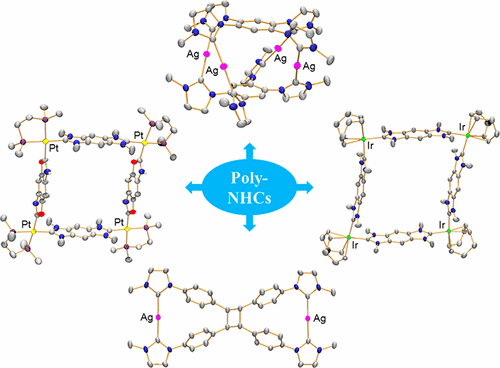当前位置:
X-MOL 学术
›
Acc. Chem. Res.
›
论文详情
Our official English website, www.x-mol.net, welcomes your feedback! (Note: you will need to create a separate account there.)
Metallosupramolecular Architectures Obtained from Poly-N-heterocyclic Carbene Ligands
Accounts of Chemical Research ( IF 18.3 ) Pub Date : 2017-08-25 00:00:00 , DOI: 10.1021/acs.accounts.7b00158 Narayan Sinha 1 , F. Ekkehardt Hahn 1
Accounts of Chemical Research ( IF 18.3 ) Pub Date : 2017-08-25 00:00:00 , DOI: 10.1021/acs.accounts.7b00158 Narayan Sinha 1 , F. Ekkehardt Hahn 1
Affiliation

|
Over the past two decades, self-assembly of supramolecular architectures has become a field of intensive research due to the wide range of applications for the resulting assemblies in various fields such as molecular encapsulation, supramolecular catalysis, drug delivery, metallopharmaceuticals, chemical and photochemical sensing, and light-emitting materials. For these purposes, a large number of coordination-driven metallacycles and metallacages featuring different sizes and shapes have been prepared and investigated. Almost all of these are Werner-type coordination compounds where metal centers are coordinated by nitrogen and/or oxygen donors of polydentate ligands. With the evolving interest in the coordination chemistry of N-heterocyclic carbenes (NHCs), discrete supramolecular complexes held together by M–CNHC bonds have recently become of interest. The construction of such metallosupramolecular assemblies requires the synthesis of suitable poly-NHC ligands where the NHC donors form labile bonds with metal centers thus enabling the formation of the thermodynamically most stable reaction product. In organometallic chemistry, these conditions are uniquely met by the combination of poly-NHCs and silver(I) ions where the resulting assemblies also offer the possibility to generate new structures by transmetalation of the poly-NHC ligands to additional metal centers forming more stable CNHC–M bonds. Stable metallosupramolecular assemblies obtained from poly-NHC ligands feature special properties such as good solubility in many less polar organic solvents and the presence of the often catalyticlly active {M(NHC)n} moiety as building block.
中文翻译:

从聚-N-杂环碳烯配体获得的金属超分子体系结构
在过去的二十年中,超分子结构的自组装由于其在分子封装,超分子催化,药物递送,金属药物,化学和光化学传感等领域的广泛应用而成为广泛研究的领域。 ,以及发光材料。为了这些目的,已经准备并研究了许多具有不同尺寸和形状的由协调驱动的金属环和金属环。几乎所有这些化合物都是Werner型配位化合物,其中金属中心由多齿配体的氮和/或氧供体配位。随着对N-杂环卡宾(NHCs)配位化学的关注不断发展,MC NHC将离散的超分子复合物结合在一起债券最近引起了人们的关注。这种金属超分子组装体的构造需要合成合适的聚-NHC配体,其中NHC供体与金属中心形成不稳定的键,从而能够形成热力学上最稳定的反应产物。在有机金属化学中,聚-NHC和银(I)离子的组合可独特地满足这些条件,其中所得的组装体还提供了通过将聚-NHC配体重金属化为其他金属中心而形成更稳定C的方法来生成新结构的可能性。NHC –M债券。由聚-NHC配体获得的稳定的金属超分子组装体具有特殊的特性,例如在许多极性较小的有机溶剂中具有良好的溶解性,并且存在经常具有催化活性的{M(NHC)n }部分作为结构单元。
更新日期:2017-08-25
中文翻译:

从聚-N-杂环碳烯配体获得的金属超分子体系结构
在过去的二十年中,超分子结构的自组装由于其在分子封装,超分子催化,药物递送,金属药物,化学和光化学传感等领域的广泛应用而成为广泛研究的领域。 ,以及发光材料。为了这些目的,已经准备并研究了许多具有不同尺寸和形状的由协调驱动的金属环和金属环。几乎所有这些化合物都是Werner型配位化合物,其中金属中心由多齿配体的氮和/或氧供体配位。随着对N-杂环卡宾(NHCs)配位化学的关注不断发展,MC NHC将离散的超分子复合物结合在一起债券最近引起了人们的关注。这种金属超分子组装体的构造需要合成合适的聚-NHC配体,其中NHC供体与金属中心形成不稳定的键,从而能够形成热力学上最稳定的反应产物。在有机金属化学中,聚-NHC和银(I)离子的组合可独特地满足这些条件,其中所得的组装体还提供了通过将聚-NHC配体重金属化为其他金属中心而形成更稳定C的方法来生成新结构的可能性。NHC –M债券。由聚-NHC配体获得的稳定的金属超分子组装体具有特殊的特性,例如在许多极性较小的有机溶剂中具有良好的溶解性,并且存在经常具有催化活性的{M(NHC)n }部分作为结构单元。



























 京公网安备 11010802027423号
京公网安备 11010802027423号